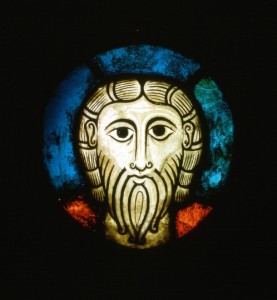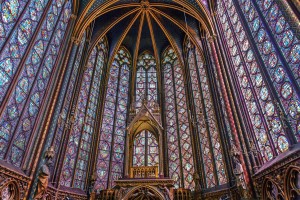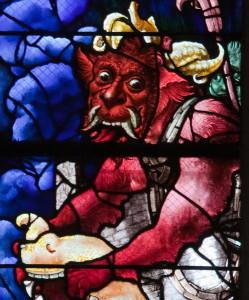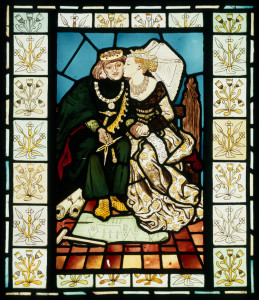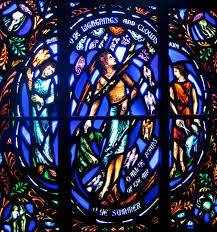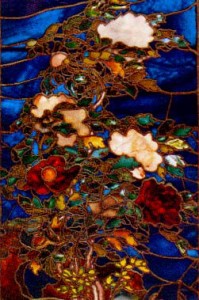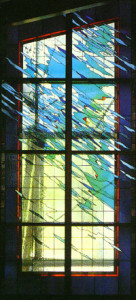Early Stained Glass
Dates from between 1040 and 1056 AD. This fragment is known as the Head of Christ of Wissembourg and is held in Le Musee de l’Oeuvre Notre-Dame in Strasbourg, France
Stained glass began primarily as a Christian art form. While it is impossible to pin down the origins of stained glass art it is evident that by the European Middle Ages, early glass artists had been inspired by the developments of the goldsmith, the cloisonné enameller, and the tradition of tile mosaics. Having developed the ability to produce relatively large pieces of colored glass, the next step was the use of a lead instead of a gold framework to hold together pieces of glass as a window rather than a broach or a wall decoration. The medieval artist also discovered that iron filings mixed with powered glass could be formed into a paste that could be painted on glass to depict various images such as, faces, hands and drapery. When fired at a temperature close to the melting point of glass the images became a permanent part of the glass. While there are records of colored glass being used by St. Gregory in St. Martin of Tours in the sixth century the evidence for prototypes of stained glass windows is very scarce. The spread of Christendom throughout Europe, however, would make stained glass the dominant art form of the new millennium. While medieval craftsmen were often quite cultured, they depended upon the works of traditional scholars for their designs and decoration of cathedrals. The church fathers were well aware of the ability of stained glass “to illumine men’s minds so they may travel through it to an apprehension of God’s light”, as well convey the stories and messages of the Bible to an illiterate populace. More than anyone else Suger, the abbot of St. Denis from 1122 to 1151 and confidant to kings Louis VI and Louis VII, helped bring about a revolution in architecture and stained glass which we refer to as the Gothic style.
The Gothic Era
St. Chapelle, Paris
Abbot Suger’s vision to illumine men’s minds was helped by the innovations in architecture that later came to be known as Gothic. Flying buttresses and vaulted ceilings made it possible for a large portion of the wall space of the cathedral to be filled with glass. St. Denis was consecrated June 11, 1144 and served as a standard for new designs in stained glass that would eventually replace those of the smaller, Byzantine like Romanesque windows. Unfortunately, the windows of St. Denis were mostly destroyed during the French Revolution, although fragments and entire windows can be found throughout Europe in churches and private collections. The explosion of Gothic architecture soon after St. Denis would serve as the foundation of the art of stained glass. After the Norman conquest of England, French stained glass artists migrated to England and the earliest stained glass windows in England can be found in York Minister dating back to around 1150. Flemish and German artist were soon to follow on their heels.
Gothic architecture was a bold experiment that jettisoned Europe out of the middle ages and allowed medieval glaziers to produce visions of paradise with their glass. Northern Europe inevitably became the backdrop for the development of large walls of glass in cathedrals. The intense southern sun of Italy and Spain made the development of large scale windows impractical in those areas. Unparalleled as an example of the gothic style is Chartes Cathedral in France. Glaziers constructed windows not knowing what the outcome of their labors would look like in natural light, but created one of the most harmonious and vibrant collections of glass ever assembled. Chartes is know for its subtle variations of rich blues and reds. Over four thousand donors are depicted in the windows as well as images of everyday medieval life. The bold use of lead lines, receding blue backgrounds and stylized two-dimensional imagery are typical of the gothic style at Chartes and other gothic cathedrals.
But the development of stained glass design and production was not even throughout the middle ages. Constant war , famine, and plagues destroyed much of the original glass and often made such a large corporate endeavor unmanageable. The rise of new national identities also tended to create strong regional differences in aesthetics. Germany remained conservative and Romanesque with dark, heavy figures, while French artists developed grater animation of figures by using rapid sketching techniques. By the fourteenth century glass techniques in England had produced elaborate traceries that lifted the eyes toward heaven. English glaziers reveled in the lives of northern saints and held great fascination with the grotesque. They further developed the use of grisalle, large expanses of light colored and clear glass designed to allow the maximum penetration of light. Even amid chaotic social conditions there were many technical innovations in stained glass production during the fourteenth century. One anecdote describes the accidental discovery of silver stain. When a silver button of one of the glaziers fell onto a piece of glass during the firing process it resulted in a rich gold stain on the fired piece. The eventual application of silver oxide to glass before firing, allowed the artist to obtain rich and varied hues of gold and yellow on clear glass, a prominent feature of most late medieval glass. This most probably is the technique which gave stained glass its venerable name. Flashed glass was developed at this time, greatly increasing the artists pallet. Two layers of glass were fused together one on top of the other to produce different colors. Many refinements also occurred in the painters techniques allowing for greater variations in shading. All of these were to foreshadow the Renaissance, the development of realism, the painterly art, and the eventual diminution of the art of stained glass.
The Renaissance and Reformation
Beauvais – Saint-Etienne – Devil of the Last Judgement Window
During the first three decades of the fifteenth century, as the Middle Ages began to wane, the high Gothic style of stained glass continued to flourish with the influx of new found wealth from the seeds of capitalism in Italy and Flanders. By the mid 1400’s, however, the new realism in painting by people like Jan Van Eyck, and eventually the great Renaissance painters, led to a decline of traditional stained glass. Painters now became glass designers, and their attempts to portray minute details did not translate into the Gothic style with its bold lead lines and strong figures. Glaziers began to imitate fresco and easel painting, which gradually began to obscure the beautiful translucency of the glass, the essence of Gothic windows.
This is not to say, however, that there wasn’t a prodigious amount of stained glass produced during the Renaissance with occasionally exceptional masterpieces. As in Renaissance painting, it is easy to see the changes in stained glass from the medieval period. Figures were depicted as individuals with attention to realism through delicate shading. The development of linear perspective is evident in the prominent use of architectural settings with bold receding columns and elaborate decorative detail. Secular scenes became more prominent, and with a disdain for the enormity of Gothic cathedral architecture, more in proportion to man than God. Lead lines that interfered with the naturalistic designs of the painter were eliminated, until whole windows simply became paintings on glass. Advances in enamel paints made bright and colorful scenes possible, but the power of the glass itself was obscured. Because of the wholly unaesthetic appeal of too much paint on glass, painters turned their eyes elsewhere, the quality of glass painting declined, and stained glass basically became a lost art.
Until the sixteenth century stained glass was primarily a Catholic art, depicting a panoply of images of Catholic saints and traditional icons of the Church. With the coming of the Reformation, Calvinist reaction to Spanish repression in the Netherlands, Henry VIII’s break from the Church, and vicious wars of religion in Germany, stained glass was recklessly destroyed throughout Europe because of its “popish” imagery. In 1644 the English Parliament ordered all images of the Virgin Mary destroyed. A fanatical Puritan rector of Canterbury Cathedral, Richard Culmer, Stood on a ladder sixty steps high and attacked the stained glass image of Becket with a pike. These scenes were repeated all over Protestant Europe. The destruction of glass making facilities and the subsequent dearth of colored glass led to the use of more clear glass with enamel paint and silver stain used to produce stained glass like effects.
Religion was not the only factor in the decline of the use of colored glass. The new Baroque style with its painted interiors and sumptuous decoration required the use of more clear glass. Bright interior light had become the fashion in Paris. The upheaval of the French Revolution also was responsible for the destruction of glass artifices of the nobility throughout France. Fortunately, many French windows found their way to England where they were preserved. In general, the taste in stained glass declined after the Renaissance. Many stained glass windows, which required intermittent restoration of decaying leads, were lost through lack of attention, and few new windows were created until the Gothic Revival of the nineteenth century.
The Gothic Revival
Lady With Fruit by William Morris, c. 1870
By the late seventeenth century there was a growing movement in Europe for a more romantic vision of life. Particularly in England with its “satanic mills”, people longed for exotic places far from the degradation of factory life. Emotional outpouring and fanciful daydreams became ends in themselves. Along with these new sensibilities came the desire for a type of architecture that would house the strongest imagination of the times, and it was to Gothic architecture that these visionaries would turn. Along with this renewed interest in Gothic architecture came a new appreciation of stained glass. Throughout much of the nineteenth century glass artists continued to use the technique of enamel painting on clear glass, but as Gothic architecture became more popular, glass artists began to realize the superior quality of the pot metal glass used in medieval glass. Having lost the technique of the use of the lead lines, many artists of the time floundered trying to recapture the tension and dynamism of the Gothic window. As descendants of the Renaissance style of realism, painters were unable to give up their “modern” depiction of figures, scenery, and ornamentation. While the openings for the new windows were truly Gothic, the art of the windows was a curious combination of the old and the new . Gradually the medieval technique of constructing a window out of a mosaic of small pieces of colored glass and using enamel paint only as shading for the drawing became more accepted.
Some of the finest examples of this renewed interest in the glass itself were created at the stained glass studio of William Morris at 8 Red Lion Square, Holborn. The original partners included Morris, Edward Burne-Jones and D.G Rossetti, members of the Pre-Raphaelite Brotherhood. Morris and the Brotherhood believed that machine production had degraded everyday life with the prodigious output of inferior goods. This led to an obsession with craftsmanship and detail which is evident in many of the windows of the time. Preeminent were the designs of Burne-Jones, whose use of lavish foliage and ethereal figures became a standard for representation during the Victorian period, as well as an influence in the development of Art Nouveau.
The Gothic Revival was a movement that enveloped many styles. While many designers labored over recreating medieval motifs most glass artists infused their work with a combination of Renaissance and contemporary ideals that produced a wholly new art form. Most importantly, the rediscovery of the power of glass during this time revived the “lost art” of stained glass and inspired glass artists to experiment with new forms of glass and design.
“Summer”, Daniel Window, Heinz Memorial Chapel. Photo credit Pittsburgh History and Landmarks Foundation
Opalescent Glass, Tiffany and La Farge
Red and White Peonies by John LaFarge, c. 1885
The opulence of American Industrial Society produced a shift of taste away from Gothic Revival architecture to a renewed interest in classical forms embellished with the grandeur of the Renaissance. Families such as the Vanderbilts constructed enormous “chateaus” filled with stained glass, but the nature and design of much of this glass was peculiarly American. The new “American” glass preferred by Tiffany, La Farge, D. Maitland Armstrong and other glass artists was called opalescent glass. Unlike antique pot-metal glass that is relatively translucent, opalescent glass reflects as well as refracts light. The milky and swirling mixture of colors in opalescent glass was a perfect compliment to the marble and stone interiors of most neo-classical structures. While opalescent windows let in less light than traditional windows, electricity provided the key for lighting the dark neoclassical interiors filled with finely carved statuary and elaborate fixtures. As you would expect with any classical motif, the opalescent glass designers relied heavily on statuary forms with figures standing in niches or surrounded by columns.
John La Farge was the first designer to incorporate opalescent glass into a window and received a patent for his new product on February 24, 1880. Louis Comfort Tiffany, a member of the family renowned for their silver firm, received several patents for variations of the same opalescent process in November of the same year. La Farge was persuaded by Tiffany with hints of a future partnership and possible collaborations to waive his patent. The promises never materialized while competition and animosity grew between the two artists. Eventually Tiffany became the darling of the Gilded Age industrialists and he created a glass and decorating studio that boasted more than a hundred workers. La Farge remained the lone artist who contracted out fabrication of his designs to smaller studios. Beyond Tiffany and La Farge a plethora of stained glass studios developed in America around the turn of the century.
The work of Tiffany and La Farge at its best is romantic and contemplative. Unique to their work was the glass itself which could be used to portray the depth of color in a bending flower petal or a variation of atmospheric effects in a spectacular sky. Tiffany was particularly successful in his development of the landscape windows, some of which contained thousands of tiny pieces of glass used for individual leafs, berries and flowers. Tiffany became just as famous for a small offshoot of his window business, the design and fabrication of art glass lamps. While Tiffany created his prodigious empire, sometimes producing uninspired stock designs thousands of times over, La Farge created unique one of a kind windows noted for their strong emotional content and bold use of color. Among the three hundred windows credited to La Farge more than a few are seen as masterpieces.
Contemporary Stained Glass
Kazuni Ikemoto 1985
Stained glass of the twentieth century is best characterized by a lack of any distinctive style. Ultimately dependent upon developments in architecture, the stained glass profession of today has found itself in both a precarious and innovative situation. Much of the stained glass production between the world wars and immediately after was intended to replace the hundreds of thousands of windows destroyed in these wars. Many artists simply copied the windows and styles that had already existed, but by mid-century bold innovations were carried out by famous artists whose themes were often secular in nature. Matisse, Braque, Leger and others broke the traditional figurative mold of earlier times with their abstract and semi-abstract designs, works that would become art in their own right.
Eventually, the diminishing number of churches built throughout the second half of the century led to the decline of the large stained glass studio run by master craftsmen and constantly rejuvenated by apprentices. The bastardization of residential architecture with the explosion of suburban “boxes” also left little room for innovative decorative work. Urban skyscrapers and modern office buildings, however, provided a unique new setting for the glass artist. The corporation had replaced the cathedral as the center of cultural and moral values, and much of the glass created for those venues reflected the austerity and abstractness of the corporate world. In recent years peoples’ obsession with dining out has also created a new market for decorative glass in restaurant facades and interiors.
The small stained glass studios of today, often dependent upon restoration commissions for survival, continue to experiment with new techniques and designs. Similar in scope to the Romantic Movement of the nineteenth century, a yearning for transcendence from an impersonal, mechanized world has begun to take place in modern society. With this intensified desire to travel beyond the average-everydayness of contemporary life, stained glass will again provide both the saint and sinner with a vision and a refuge.

